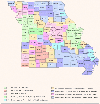Rural-urban difference in female breast cancer diagnosis in Missouri
- PMID: 26223824
- PMCID: PMC12392156
Rural-urban difference in female breast cancer diagnosis in Missouri
Abstract
Introduction: The stage at cancer diagnosis has a tremendous impact on type of treatment, recovery and survival. In most cases the earlier the cancer is detected and treated the higher the survival rate for the patient. The purpose of this study was to examine the impact of spatial access to healthcare services on late detection of female breast cancer diagnosis in Missouri, taking into account access and distance to the nearest mammography center and/or hospital.
Methods: This was a cross-sectional retrospective study of female breast cancer diagnosis in different geographic regions of Missouri. The sample was restricted to Missouri women diagnosed with breast cancer, whose cases had been reported to the Missouri Cancer Registry and Research Center between 2003 and 2008. A geographic information system network analysis was used to calculate distance traveled by road from the centroid of each county to the nearest healthcare facility.
Results: A total of 28 536 cases of female breast cancers were reported to the Missouri Cancer Registry and Research Center between 2003 and 2008. Of these 25 743 (90.2%) were Caucasian (white) while 2793 (9.8%) were African-American (black). Analysis showed that the proportion of African-Americans with late-stage detection exceeded that of whites in almost all rural and urban locations. From 2003 to 2005 more than 50% of all late-stage diagnoses of African-American women occurred in metropolitan (metro) medium (55.6%) and completely rural counties (66.7%). Other locations recorded a smaller number of late-stage detection among African-American women: metro small (42.3%), urban large (47.4%) and urban small (44.9%) counties. Most of the late-stage diagnoses of white women were reported in urban small (32.2%) and rural (32.3%) counties. Between 2006 and 2008, again, the proportion of late-stage diagnoses among black women was the highest. Access to hospitals is fairly distributed among all counties. Women from disadvantaged non-metro areas have the same level of access to hospitals as those in metro areas within a travel time of 15 to 30 minutes. However, although there are almost 180 mammography screening centers across the state, access to these services is not evenly distributed. A network analysis of the closest facility of the type showed that women living in 19 non-metro rural counties have to travel more than 45 minutes one way by car for mammography services. Thirteen of the 19 counties are classified as completely rural.
Conclusions: Women with breast cancer living in areas with limited access to healthcare services are more likely to have been diagnosed with late-stage breast cancer.
Keywords: Cancer; North America; Public Health; Sociology; Women's Health.
Figures







References
-
- American Cancer Society. Cancer facts and figures 2012. Atlanta, GA: American Cancer Society, Inc., 2012.
-
- National Cancer Institute. Surveillance, Epidemiology, and End Results (SEER) (SEER). Stage distribution and 5-year relative survival by stage at diagnosis for 2002–2008, all races, females 2012. (Online). Available: http://seer.cancer.gov/statfacts/html/breast.html (Accessed 11 April 2012).
-
- Centers for Disease Control and Prevention. National Breast and Cervical Cancer Early Detection Program. (Online) 2011. Available: http://www.cdc.gov/cancer/nbccedp/legislation/law.htm (Accessed 11 April 2012).
-
- Department of Health and Senior Services. Show Me Healthy Women. (Online) 2011. Available: http://health.mo.gov/living/healthcondiseases/chronic/showmehealthywomen... (Accessed 11 April 2012).
-
- Jonas S, Goldsteen R, Goldsteen K. An introduction to the U.S. health care system. New York: Springer Publishing, 2007.
Publication types
MeSH terms
Grants and funding
LinkOut - more resources
Full Text Sources
Medical

